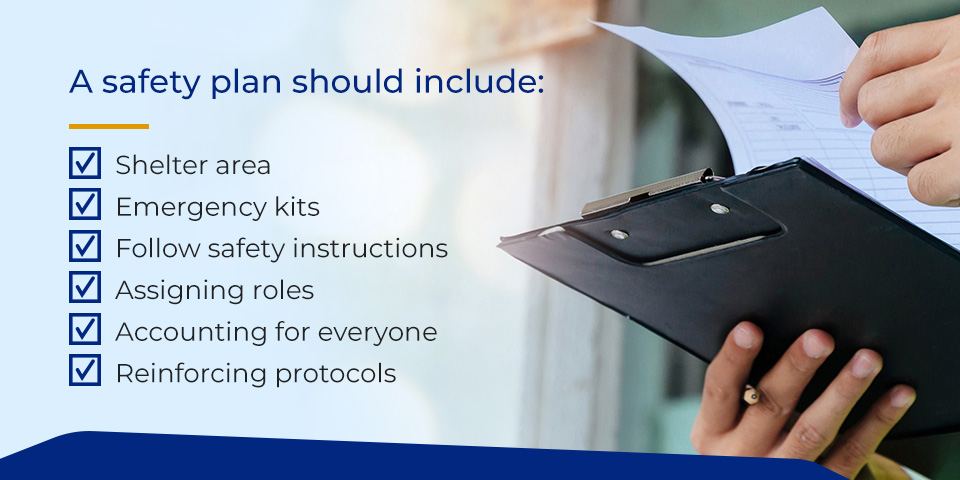Springtime weather brings ups and downs. While we might enjoy warmer days and more sunshine, there’s also the potential for thunderstorms, tornadoes, hailstorms and floods. These storms can lead to property damage and the loss of thousands of dollars for businesses. Fortunately, by taking the proper steps, you can protect your business from storms, keep operations running smoothly and maintain your reputation.
How Severe Weather Affects Businesses
Storms can interrupt your business operations, cause downtime, lead to revenue loss and pose a danger to employees, making it critical to have a storm protection plan in place. Here are the primary ways weather can impact your business:
- Inventory and infrastructure damage: Hailstorms, tornadoes, hurricanes, flooding and other severe storms can lead to costly building, equipment and inventory damage. This can be especially difficult for small businesses who might lack the resources to repair or replace their property.
- Transportation disruptions: Spring storm damage to businesses can lead to transportation disruptions, making it difficult for customers to get to or access your storefront. Employee performance is also impacted — storms can make it difficult for workers to get to work or finish projects promptly.
- Revenue loss: When your home loses power, you can sit back and light candles while waiting for the storm to pass. With your business, even just hours of downtime can lead to significant revenue losses.
- Power surges: A power surge can damage IT property. Without proper protection, you can lose data from power outages, which is critical for companies requiring 24/7 online support.
- Reputation: While spring storms can directly damage a physical storefront, they can also lead to lost inventory, power outages and evacuations that ultimately harm your company’s reputation.
7 Ways to Prepare Your Business for Storms
Creating a storm checklist and implementing specific safety measures can help mitigate property damage, keep employees safe and prevent revenue loss. Here’s how to prepare your business for tornadoes, flooding and other severe spring storms:
1. Reinforce Your Building
The first step involves inspecting and preparing your building. During a flood, for example, basements are particularly vulnerable to damage, as water will flow into them and seep into the walls. If your building has a basement, you can take the following measures to mitigate flooding damage:
- Extend downspouts.
- Seal water entry points.
- Caulk cracks in interior walls.
- Regrade your landscaping so water flows away from the building.
- Install a drainage system.
- Apply waterproof sealant to cracks in the foundation.
For tornadoes and hailstorms, you might install storm shutters on your windows and impact-resistant, sturdy exterior doors.
2. Prepare Your Employees
You’ll want to prepare your employees for storms by creating a safety plan and promoting a safe work culture. A safety plan should include:

- Shelter area: In the event of a tornado or another severe storm, you’ll want to ensure you have a safe place for employees to go. Ensure the shelter area is safe and large enough to accommodate everyone.
- Emergency kits: Place emergency supply kits in your shelter area and refresh the contents as needed. Make sure your employees know where these supplies are stored.
- Follow safety instructions: Employees should follow the appropriate safety precautions for appliances and equipment, such as not using a stove for heating or staying away from electronic equipment.
- Assigning roles: Your employee safety plan should delegate people to monitor the weather, signal a warning, and usher visiting clients, vendors and other guests toward shelter.
- Accounting for everyone: You should also have a way to account for everyone, such as an employee checklist for each shift, in order to keep track of personnel and ensure their safety.
- Reinforcing protocols: Most importantly, ensure that your employees understand the safety plan. Conduct tornado drills until your plan becomes second nature. Promote a culture of workplace safety, ensuring that all employees take warnings seriously and act quickly.
3. Gather Emergency Supplies
As a business owner, ensure that you keep emergency storm supplies available in your building and in working order. Include these items:
- Flashlights
- Water bottles
- Backup generators
- First-aid kits
- Extra batteries
- Battery-operated weather radios
- Blankets
- Toolsets
Also, keep an up-to-date contact list of state and local entities, making sure your staff knows where it is.
4. Secure All Outdoor Assets
Examining the outdoor perimeter and securing loose objects can help prevent spring storm damage to businesses. If you know a storm is on the way, you might take the following precautions:
- Secure and lock windows and doors.
- Bring in outdoor furniture or safely secure it.
- Install hail guards on your HVAC systems.
- Clear storm drains to allow water to flow away from your property.
- Trim trees prior to storm season to prevent further damage.
5. Back up Your Data
Regardless of the storm risk, it’s critical that your disaster recovery plan includes backing up all data. This will help you safeguard the information your company needs to keep operations running smoothly. Whether it’s point of sale (POS) data, accounting files or other types of databases, data backup can ensure your business’s continuity. Backing up your data is crucial to prevent cyberattacks as well.
6. Implement Communication Protocols
As mentioned, you should have some type of communication protocol in place when preparing for spring storms. Having one can help you distribute information to impacted parties as quickly as possible. You’ll want to outline the entities to be contacted in case of an emergency and include their contact information to keep employees and customers safe. Keep an updated list of the following information:
- State and local emergency phone numbers
- Employee contact phone numbers
- Employee emergency contact names, relations and phone numbers
7. Obtain Business Insurance Coverage
The days following a storm can be overwhelming and stressful for you, your business, and your employees and customers. When you purchase tornado insurance or another type of insurance that includes storm coverage, you can help reduce risks associated with property damage.
Review insurance policies to ensure you get proper coverage for storm-related damages. By partnering with an insurance agency, experts can help you find the right insurance for your business, giving you peace of mind that it protects you during severe weather.
Purchase Storm Protection for Your Business
It’s important that you prepare your business for spring floods and storms, as they can occur at any moment. Flooding and water damage can render a building inhabitable, while power outages and tornadoes can disrupt your operations and lead to revenue loss. As a business owner, it’s important to have a storm insurance policy that can help alleviate these risks.
At Gunn-Mowery, we can help you find the insurance plan and coverage that works for your business. We understand the losses that can occur from storms, and we want to help you keep your business and assets protected. We constantly strive to meet your insurance needs so you have peace of mind someone is always on your side.
To learn more about our services, contact us today. An Upside agent will be happy to get you a quote in no time.

